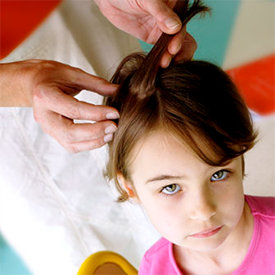How To Check for Head Lice
Most parents are fearful of the idea that their children will contract head lice, yet until they actually do battle head lice, those same parents have no idea how to check for it. If you have never seen it, how would you know? It would seem logical to turn to the internet for advice, but unfortunately, the web is chock full of misinformation. But knowing how to check and checking often is your greatest defense against a really tough infestation. Here’s what you need to know about how to check your child for head lice:

It is easiest to start looking at the nape of the neck and work your way up toward the front of the hair. If the child has long enough hair, you should pull it up into a ponytail with one hand, and slowly work your way up, pulling small, paper-thin sections of hair down and examining each hair closely. You should concentrate at the base of the hair, as the lice eggs are going to be found glued to the hair shaft, quite close to the scalp. When these eggs are new, they are dark brown in color, and on blonde hair can look like specks of dirt. Newer nits can be more difficult to see on children with darker hair, as they can blend in quite well. Nits that are not viable, or that have already hatched can appear clearish, like droplets of water, or white, but will still be firmly attached to the hair. Nits are most often found at the nape of the neck, the crown of the head, or the hairline around the front or sides of the head.
Often, dandruff is mistaken for lice eggs. Lice eggs will be firmly attached to the hair and will feel like a hard speed bump if you run your fingers over them. They will not slide down the hair shaft with your fingertips. If you are seeing white debris that appears to be on the hair but will slide under your fingertips, you are more than likely looking at dandruff, not nits.
As soon as you find any evidence of lice or eggs, you should take action immediately. Fresh Heads Lice Removal offers guaranteed lice removal services and we are available by appointment 7 days a week.





